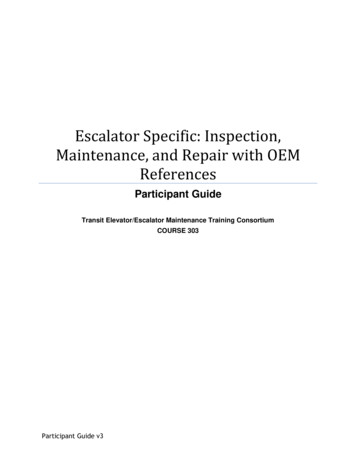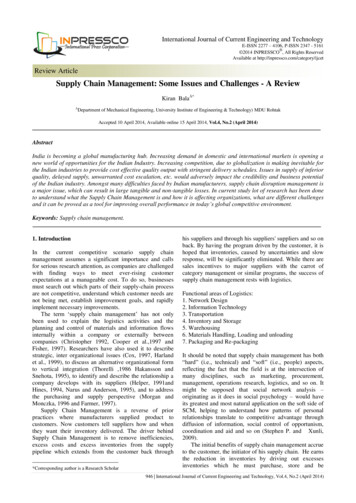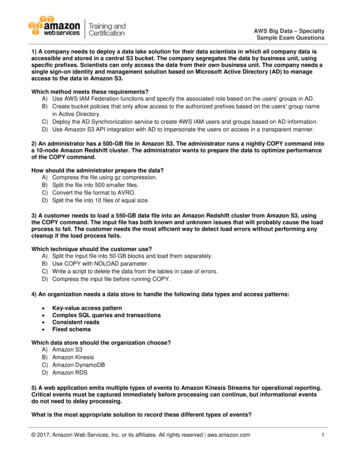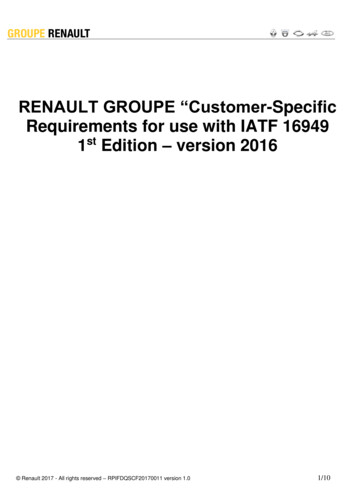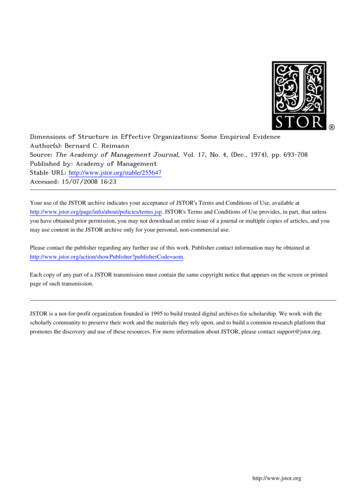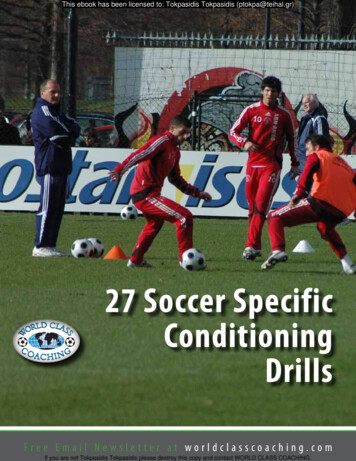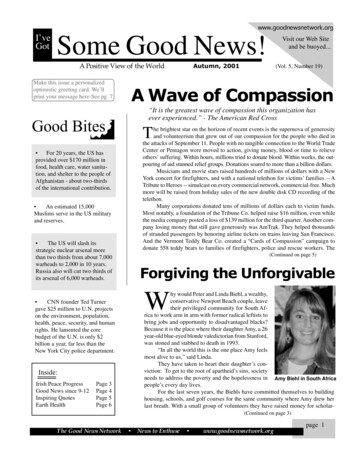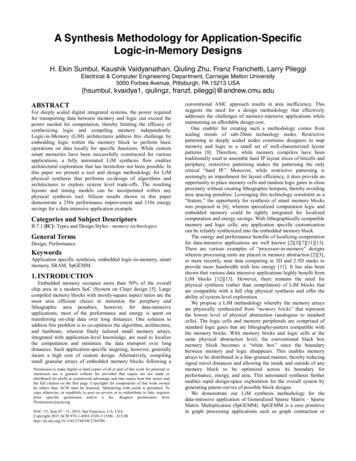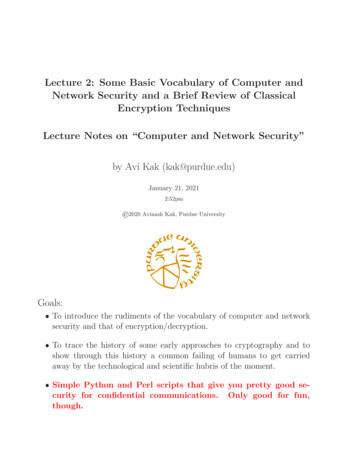
Transcription
CHAPTER 5SOME SPECIFIC GUIDANCE ON ARMY CORRESPONDENCECHAPTER OBJECTIVE:When you have completed this lesson, you should be able to perform the followingtask.TASK:Name and define the parts of a memorandum, the staff study and the decision paper.CONDITION:Given several questions relative to a review of the staff study and decision paper, andtheir parts and purpose. You may use Lesson 5, Some Specific Guidance on ArmyCorrespondence, which explains these concepts.STANDARD:Identify the basic parts of a staff study and a decision paper and their purposes inArmy correspondence.REFERENCES:AR 25-50, Preparing and Managing Correspondence and DA Pamphlet 600-67,Effective Writing for Army Leaders.5-1
CHAPTER 5SOME SPECIFIC GUIDANCE ON ARMY CORRESPONDENCE1.INTRODUCTION. Army Regulation 25-50, Preparing and Managing Correspondence, gives specificguidance on the many correspondence formats used by the Army. In this lesson we will review the informalmemorandum, the staff study, and the decision paper.2.MEMORANDUMS.a.The basic format for Army correspondence is the formal memorandum. It is used to correspondformally (internally and externally) with any command, staff, or activity within the Department of Defense.b.You can modify the basic format to create the various other types of memorandums used in theDepartment of the Army. However, critical reasoning, creative thinking, the five steps of effective writing, andelements of style are common to all memorandums. Three common modifications are the Informal Memorandum,Memorandum for Record, and Memorandum of Agreement (or Understanding).(1)The Informal Memorandum. Commands use the informal memorandum to communicateinformally within a unit, organization, or agency. Its format is the same as the formal memorandum, except that you donot use letterhead stationery.(2)The Memorandum for Record. The purpose of the Memorandum for Record (MFR) is todocument conversations, meetings, and other events for future reference. Its format is the same as the informalmemorandum, except the word "RECORD" appears in the place of the addressee.(3)The Memorandum of Agreement (or Understanding). The Memorandum of Agreement (orthe Memorandum of Understanding) is to document agreements or understandings. The format is the same as thememorandum except for two changes. First the phrase "MEMORANDUM OF AGREEMENT" or "MEMORANDUMOF UNDERSTANDING" appears on the second line below the seal. Second, a signature block appears for each partyentering into the agreement or understanding.c.Format rules for a memorandum.(1)The Heading.(a)Use letterhead stationery for the first page only. If not available, use plain whitepaper.(b)Put the suspense date at the right margin on the same line as the “Reply toAttention Of” or one clear space above the date of the memorandum.(c)List the office symbol of the originating office or unit flush left two lines below theseal, three lines above the MEMORANDUM FOR line.(d)In parenthesis two spaces after the office symbol add a Modern ArmyRecordkeeping System (MARKS) number. This number indicates where to file the document.(e)Type the date of signature flush right on the same line as the office symbol. Usemilitary dates in memorandums. For example: 23 June 1999. If you abbreviate the month use upper and lower caseletters and also abbreviate the year. For example: 23 Jun 99.5-2
(f)Three lines below the office symbol line and beginning at the left margin typeMEMORANDUM FOR followed by the address line. If the address line extends to a second line, indent the secondline to start under the third letter of the word after FOR. For example:MEMORANDUM FOR Commander, Combined Arms Center and Fort Leavenworth, Fort Leavenworth, KS 66027(g)Type SUBJECT: flush left on the second line below MEMORANDUM FOR.Skip two spaces and begin typing your subject. Identify your subject clearly. Use a noun phrase.(2)The Body.(a)Begin the first paragraph on the third line below the subject line.(b)Maintain 1-inch margins all around.(c)Single-space the text, and double-space between paragraphs.(d)Acronyms, abbreviations, and brevity codes.1.Use only those acronyms, abbreviations, and brevity codes your readerwill understand. The first time an acronym is used in a document, spell it out and follow it with the acronym inparenthesis.2.Type acronyms in upper case letters without periods.Don't useapostrophes to form the plurals.(e)Separate each major section by using numbered paragraphs and lettered ornumbered subparagraphs with clear headers. All major sections begin at the left margin.(f)Subparagraphs.Indent all first level subparagraphs four spaces and begin typing on the1.fifth space. Indent second level subparagraphs eight spaces. Wrap all second and succeeding lines to the left margin.2.If you create an "a" subparagraph, you must also have at least a "b"subparagraph. If you have a "(1)," you must also have a "(2)." Do not subdivide paragraphs beyond the thirdsubdivision; however, do not indent any further than the second subdivision.(g)Continuation pages.1.Put the office symbol at the left margin on line eight of each continuationpage. Do not type the date.2.Type the subject line (worded exactly as on page 1) on the lineimmediately following the office symbol (don't skip a line).3.Center the page number 1 inch from the bottom of the page starting withpage 2.(3)Point of contact. If you have a point of contact (POC), list the rank, name, office, andtelephone number in the last paragraph.(4)Authority line. Use an authority line (FOR THE COMMANDER, FOR THE DIRECTOR,etc.) if applicable. The authority line is flush left on the second line below the last paragraph.5-3
(5)Signature block. Type the signature block on the fifth line below the last paragraph or theauthority line (if included). The signature block starts at the center of the page. Spell out the name of the signingofficial in all upper case letters. Rank and branch may be all upper case or, if spelled out, upper and lower case. Forexample:JOHNNY P. JONES, JR.2LT, FACo, FSOJOHNNY P. JONES, JR.Second Lieutenant, Field ArtilleryCompany Fire Support Officer(6)Enclosures. Type the number of enclosures and the word "Encls" flush left on the same lineon which the signature block begins. Number and attach enclosures in the order they appear in the text. Identify themin the text (Encl 1, Encl 2, etc.) and list them after the enclosure line. List them in the same way you would areference. If you have only one enclosure, use the word "Encl," and do not number it. For example:3 Encls1. Memo, office symbol, date, subject2. DA Form3. AR #-##NAMERANK, BRANCH (or Rank, Branch)Duty PositionEnclDA FormNAMERANK, BRANCH (or Rank, Branch)Duty Position(7)Distribution. Type DISTRIBUTION: flush left on the second line after the signature blockor the last listed enclosure (whichever is lower on the page). To use the distribution line, you must have statedMEMORANDUM FOR SEE DISTRIBUTION in your MEMORANDUM FOR line. List the addressees in logicalorder, each on a separate line immediately below the word DISTRIBUTION.(8)Copies furnished. Type CF: on the second line after the signature block, the last listedenclosure, or the last addressee in the distribution list (whichever is lower on the page). List all addresses in logicalorder, each on a separate line immediately below the word CF. Show whether or not enclosures are included by addingeither “(w/encls)” or (wo/encls)” at the end of each CF address.(9)Figure 5-1 gives a sample of the memorandum format.5-4
DEPARTMENT OF THE ARMYOrganizational Name/TitleCity, State Zip CodeS: Suspense DateDate of Signature121231212312121212121212123451212OFFICE SYMBOL (MARKS NUMBER)MEMORANDUM FOR Addressee’s Duty Position or Title, Organization, City, State, Zip CodeSUBJECT:1. xxa. xx(1) xx(2) xx(a) xx(b) xxb. xxAUTHORITY LINE: (If needed)2 Encls (If needed)1. xx2. xxNAMERANK, BRANCHDuty PositionDISTRIBUTION: (If needed)Addressee’s Duty Position, UnitCF: (If needed)Duty Position, UnitFigure 5-1. Memorandum format.3.THE STAFF STUDY. The staff study incorporates the elements of critical reasoning, creative thinking, thefive steps of effective writing, and the elements of style to produce a document your commander can effectively usewhen making important decisions. The staff study follows a pattern that proceeds from identifying the problem todeciding on the best course of action (see 5-2).STAFF STUDYStep 1:Step 2:Step 3:Step 4:Step 5:Step 6:Step 7:Identify and state the problem.List facts and assumptions.Develop possible solutions.Research and collect data.Interpret data.Evaluate alternative solutions.Prepare the staff study.Figure 5-2. Staff Study.a.Objective. The objective of this section is to show you (1)How to plan and prepare a staff study.5-5
(2)How to refer to appropriate references, gather background material, and coordinate theseactions.b.Purpose. The purpose of the staff study is to assist your commander, or other superior, in making adecision. To serve this purpose a staff study must incorporate the following principles of effective writing:(1)Clarity. There must be no doubt of your meaning.(2)Brevity. Your commander should be able to get a clear picture of the problem and therecommended solution with a minimum of reading. However, you should never sacrifice brevity for clarity.(3)Accuracy. There must be no factual or mechanical errors. Check and recheck source dataand the final paper so that your commander can accept the paper with confidence.(4)ideas clearly shown.Coherence. You should present your ideas in a logical order with the relationships between(5)Unity. Your paper must deal with only one subject--the problem. Keep away from sideissues and irrelevant material.(6)Completeness. You must cover every angle of the problem, including all reasonable coursesof action. All papers needed to put the recommended action into effect should accompany your study.(7)Objectivity. Your paper must present an unprejudiced viewpoint.c.Research. To solve a problem, the author of a staff study must research the problem to identify theissues, develop and evaluate alternatives, and recommend effective action based on relevant facts.d.Preparing the staff study. The most difficult task in preparing a staff study is the beginning. Werecommend you review Lesson 1, Critical Reasoning and Creative Thinking, and Lesson 2, Steps to EffectiveCommunication.(1)Identify and state the problem. This step is crucial as the actual problem may not at first beobvious. Therefore, before undertaking the study, you must determine exactly what the problem is and clearly definethe problem's scope and limitations. Then you write the problem statement and submit it for approval to the authoritydirecting the study.(2)List facts and assumptions. Next list all facts and assumptions bearing on the problem.Identify those that are known. Examine the inferences underlying the facts and assumptions and the effect they mayhave on possible conclusions. Develop a plan of attack that enables you to identify the information you need, thesources of information, and what agencies to consult. Establish the criteria which you will use to analyze both data andpossible solutions.(3)Develop possible solutions--courses of action (COA). Analyze the subordinate topics youhave identified and list what facts and assumptions you know about each one. You are trying to identify possiblesolutions to resolve the problem and fulfill the mission. A helpful technique is to list the subordinate topic and thenbrainstorm assumptions and solutions for each one before doing the actual research. Next evaluate each solution andselect the best available solution. (There may be more than one that is equally good, but try to narrow the alternatives.)Now analyze the alternatives, and the best solution against previously determined evaluation criteria using an"advantages and disadvantages" format. One way of determining the advantages and disadvantages of a possiblesolution is to prepare a checklist.5-6
(4)Research and collect data. After developing possible solutions, you begin to collectadditional information from technical libraries, abstracts, DOD document center, subject-matter experts, operationalpersonnel, etc.(5)Interpret data. Data by itself is useless, it must be interpreted. Apply the standards ofcritical reasoning and creative thinking (lesson 1) to determine the feasibility, acceptability, and suitability of tentativesolutions the data supports.(6)Evaluate alternative solutions – courses of action (COA). Apply the criteria you haveestablished to the known facts and assumptions. Next compare and contrast the alternatives. The best solution will bethe one most feasible, suitable, and acceptable that fulfills the evaluation criteria.SAMPLE PROBLEM AND SOLUTIONa.Problem. The problem is to select a site for a 50-target, known-distance rifle range at Camp Targee.But there is a special condition imposed by Tenth U.S. Army--the site must conform to the requirements of theemergency expansion plan. This is an important element of the problem and has a direct bearing on the solution.Tenth U.S. Army has also implied that, if fully justified, they will approve the purchase of additional land.b.Assumptions. You have made the assumption that because Camp Targee has an assignedmobilization mission there will be no change in the mission. By making this basic assumption, you can accept allaspects of the mobilization as documentable facts. You can accept that the acquisition of land and the rangerequirements even though based on future developments are valid. Tenth U.S. Army has also stipulated that thecommand is to justify any additional land acquisition before they grant any approval. However, the approval is not afact; therefore, you must include it as an assumption.c.Facts bearing on the problem. You have listed several facts that are important and pertinent to thesolution of the problem. You have arranged these in a logical sequence for discussion.(1)Tenth U.S. Army says that Camp Targee will be one of the first installations they willexpand if mobilization occurs. This fact has a direct bearing on the problem because it indicates time will be a vitalfactor carrying out the emergency expansion plan. While it is not wrong to do so, there is no need to include themobilization mission of the post since we can assume the commander is aware of it. It can also be assumed that thecommander is familiar with the emergency expansion plan; however, it is the duty of the writer to determine whichelements of the plan have a direct bearing on the problem. An analysis of the notes from the emergency expansion planreveals that the most important elements are those concerning the range requirements and the additional land toacquire. The commander must have these facts to make a decision, and he should not have to look beyond the body ofthe study to find them.(2)The second fact is stated in general terms. The commander who will approve or disapprovethe study has had considerable experience as an infantry officer. You can assume, therefore, that the commander has atleast a general knowledge of range requirements. If he desires to study them, the annexes will give him detailedinformation. The fact that Tenth U.S. Army directed we try to locate the range on the post is essential for an objectiveconsideration of the problem.(3)Tenth U.S. Army’s position is that you must justify the acquisition of additional land.Therefore, the commander will want to know the location of the sites being considered. The fact that Sites I and II arethe only adequate sites on the post is essential. This immediately assures the commander that you have investigated allpossible sites on the post. Since Site III is located off-post on land designated for acquisition under the emergencyexpansion plan, the commander will be particularly concerned with the justification for use of this site. Inclusion aboutthe location of the sites sets the stage for the discussion to follow.Figure 5-3. Sample problem and solution.5-7
d.Discussion. One way of determining the advantages of each site is to prepare a checklist.Below is an example of a checklist for this staff study.Checklist for 50-target, known-distance rifle range atCamp Targee10th Army RequirementsSite conforms to emergency expansion planLocated on present post (conditional)General Requirements, TM 0-0000-000-00Within 30 minutes marching time of cantonment areaGood drainageMinimum danger area required forOne rangeSmall arms and field target rangesCan use artillery impact areas as common impact areaAvoids isolating useful maneuver areasDoes not prevent use of existing roads (expansion area)Greatest economy in mobilization constructionCosts less to build one rangeSITE #1YesNoXSITE #2YesNoSITE #3YesNoXXXXXXXXXXXNAXXXXXXXXXXXXXXThe chart above is only a partial listing of the advantages and disadvantages. This method makes it relativelysimple to write the discussion paragraph of the study.e.Conclusions. The objective analysis developed in the discussion leads naturally to a logicalsolution.(1)Site I must be eliminated because it does not conform to the requirements of theemergency expansion plan. Site I is not expandable and will be destroyed when the cantonment expands.(2)Site II does not meet all of the mobilization requirements. It lacks a common impactarea for the artillery, small arms, and field target ranges; this will increase the acreage needed for danger areas.In addition, the required relocation of the road will add several thousand dollars to the cost of building theranges at this site. This will increase the mobilization construction cost far beyond that of Site III and willincrease the time needed to make the expanded post operational.(3)Site III best meets the general requirements of TM 0-0000-000-00, and it does conformto the emergency expansion plan. Based on the information furnished and without reading other factors into theproblem, it appears that Site III is the best location. The lower mobilization construction cost fully justifies thepurchase of additional land. This lower cost will result because the impact areas and danger zones for all rangeswill need less acreage. Finally, we will not have to relocate the road, thus saving further time and money.Figure 5-3. Continued.(7)Prepare the staff study. The staff study consists of a summary sheet (body) and annexes.Along with the 10 basic paragraphs, the summary sheet may include- A list of annexes.Concurrences.Nonconcurrences.5-8
Considerations of nonconcurrences.A list of annexes added to summarize lengthy nonconcurrences and their consideration.Action by the approving authority.An implementing document.e.Staff study format. The staff study consists of 10 basic paragraphs in a memorandum format (see hbelow for the specific staff study format). The staff study paragraphs include: Problem ons.Courses of action.Criteria.Analysis.Comparison of courses of action.Conclusion.f.Coordinating a staff study. Conducting staff studies normally involves coordination with other staffofficers to obtain concurrences or nonconcurrences on desired recommendations and other aspects of the study.Coordination is important because the views of each agency involved are available to the commander. You shouldanticipate nonconcurrences. You should write considerations of nonconcurrences, assess them objectively andaccurately, and make them into enclosures (annexes) to the staff study.g.Common problems of staff studies. The following list of questions identifies the most commonproblems found in staff studies. You should review this list before beginning a staff study. Is the topic too broad?Is the problem properly defined?Are facts or assumptions clear and valid?Are there any unnecessary facts or assumptions?Are there any facts that appear for the first time in the discussion?Are
The basic format for Army correspondence is the formal memorandum. It is used to correspond formally (internally and externally) with any command, staff, or activity within the Department of Defense. b. You can modify the basic format to create the various other types of memoran
